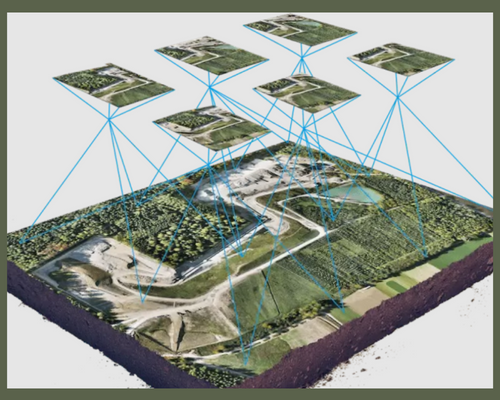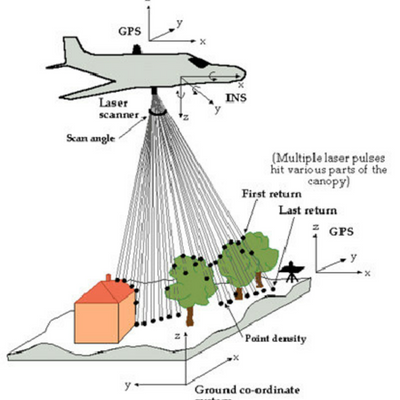Search This Blog
Most Popular
Categories
- Building Construction (87)
- Building Materials (85)
- Columns (2)
- Concrete Beam (3)
- Concrete Construction Techniques (6)
- Concrete Mix Design (14)
- Concrete Repair (14)
- Concrete Slab (11)
- Construction Equipment (17)
- Construction News (7)
- Design of Structures (18)
- Engineering Drawing (1)
- Estimation (3)
- Geotechnical engineering (26)
- Highway Engineering (11)
- Innovations (34)
- Material Testing (10)
- Matrix Analysis of Structures (2)
- Mechanical Engineering (3)
- Strength of Materials (2)
- Structural Analysis (13)
- Structural Design (24)
- Structures (17)
- Transportation Engineering (9)
The Ultimate Guide to Aerial Mapping: Techniques, Applications, and Benefits
Team Prodyogi
March 21, 2023
Aerial mapping or aerial surveying is a type of land surveying method that collects geographical information on a construction site or location using airborne vehicles or satellites. The data is collected using technologies like photography, laser, radar, or remote sensing based on which there emerged different types of aerial mapping; namely photogrammetry, LiDAR, thermal imaging, etc.
 |
The data collected from aerial mapping is used to create 3D models for the construction site, or for land or terrain to perform construction management or urban planning.
In this article, we will explore the general steps involved in aerial surveying, along with features, techniques, and applications in various fields.
How Aerial Mapping Works?
Irrespective of what method you use to perform the aerial survey, there exists a standard aerial surveying process. The general steps involved in aerial surveying are:1. Planning the Flight for the Survey
Before conducting an aerial survey, the flight path needs to be planned so that the entire area of interest is covered. The path is decided by determining the altitude, speed, and flight pattern of the aircraft or the drone.
2. Preparing the Survey Equipment
The equipment used for aerial mapping includes airborne devices like drones or UAVs that are equipped with high-resolution cameras, GPS, and other sensors to collect data during the flight.
3. Conducting the Flight and Data Collection
Once the flight plan and the drone (survey equipment) are ready, the drone is launched and flown over the construction site. During the flight, the data is collected in the form of images and videos based on what method of data collection is performed.
The data collection in aerial mapping can be performed by various methods, which primarily include photogrammetry, or by the latest technologies like LiDAR, multispectral imaging, hyperspectral imaging, or thermal imaging.
4. Data Processing
The data collected after the flight is downloaded and processed using specialized software. These data are stitched together based on the coordinates of the area to finally create a detailed map or 3D model of the construction site.
5. Analyzing and Interpretation of the Data
Construction or trained professionals analyze the map or 3D model generated after processing the data to identify any potential issues or opportunities for improvement in the project. The features like buildings, roads, water bodies, and more are identified and extracted during this process. This information is used for applications such as land management, urban planning, and environmental monitoring.
Aerial mapping itself uses a combination of methods, and techniques to collect, process and interpret data to produce accurate maps, 3D models, or other demands of visualizations.
Techniques Used in Aerial Mapping
As discussed before in the working process of aerial mapping, the technique used for data collection is one of the major processes involved. The data can be collected by various techniques or a combination of those depending on the complexity of the project. Let's discuss each technique one by one.
1. Photogrammetry
Aerial photogrammetry involves capturing overlapping aerial photographs of a specific area and specialized software are used to create 3D models, maps, and other geospatial products. Some of the software used to create 3D models and maps are Pix4D, Agisoft Metashape, Esri ArcGIS, QGIS, and Global Mapper.
2. LiDar (Light Detection and Ranging)
LiDAR uses a laser to measure the distance between the aircraft and the ground to create accurate 3D models of the terrain. Photogrammetry and LiDAR are used in combination for most aerial surveys.
3. Satellite Imagery
In this technique, the satellites orbiting the earth capture the data on the earth to create maps and 3D models of the terrain.
4. Multispectral Imaging
This method involves capturing images in multiple wavelengths of light, such as visible, near-infrared, and thermal. Multispectral imaging can be used to map vegetation, water resources, and other environmental features.
 |
| Concept of Spectroscopy in Aerial Mapping; Image Credits: G. Shaw, Hsiao-hua K. Burke |
The above figure shows the concept of imaging spectroscopy. An airborne or spaceborne imaging sensor simultaneously samples multiple spectral wavebands over a large area in a ground-based scene. After appropriate processing, each pixel in the resulting image contains a sampled spectral measurement of reflectance, which can be interpreted to identify the material present in the scene. The graphs in the figure illustrate the spectral variation in reflectance for soil, water, and vegetation. A visual representation of the scene at varying wavelengths can be constructed from this spectral information.
5. Hyperspectral Imaging
It is an advancement of multispectral imaging that involves capturing images in more narrow spectral bands. It is used to identify and map different materials and chemical compounds, such as minerals, crops, and pollutants.
6. Thermal Imaging
Here, the technique captures the images of Earth's surface in the infrared spectrum. Used to detect heat anomalies like leaks in pipelines or buildings, and to map urban heat islands and other thermal patterns.
How Aerial Mapping Differs from other Surveying Methods?
Aerial mapping is a popular surveying method in construction because it delivers various benefits when it comes to the total area covered with minimum time and maximum accuracy, and much more. Let's discuss the significance of aerial surveys that makes them different from other construction surveying methods.✅Coverage Area
Aerial surveying allows a larger coverage area compared to traditional land surveying methods. The use of aircraft or drone enables to survey of a larger area within a shorter period of time. Hence, when it comes to surveying large areas, aerial mapping is the top choice.
✅Accuracy
The method captures the data of the land more accurately from a bird's eye view. With the help of high resolution satellite images UK, or elsewhere, the technology improves the precision and detail of the data covered. This level of detail can be important for detecting even the smallest changes or features on the land surface.
This technology hence helps to provide a more comprehensive view of the terrain which helps to identify and study subtle features and irregularities on it that in most cases may not be visible from the ground.
✅Speed
The airborne devices capture data of the land within a fraction of the time, faster than what it takes for a traditional survey method to collect.
✅Cost
Aerial surveying is cost-effective compared to other traditional survey methods when it is implemented for surveying large projects.
Applications of Aerial Surveying
Aerial surveying has diverse applications and is hence considered a valuable tool for collecting and analyzing data from the air. Here are some of the applications of aerial mapping:
- Environmental Monitoring: Monitor changes in the environment [eg: deforestation, erosion, natural disasters, etc] and develop conservation strategies and emergency response plans.
- Cartography and Mapping: To create maps and 3D models of large areas quickly and accurately for land surveying, infrastructure, and urban planning.
- Real Estate and Property Management: Create detailed maps and 3D models of the properties for real estate and property development projects.
- Transportation: Map transportation networks and other transportation networks like highways, railways, and airports to plan transportation projects.
- Infrastructure Inspection: To inspect bridges, dams, and other critical infrastructure to detect any potential issues or maintenance needs.
- Agriculture: To monitor crop health and detect changes in vegetation growth to help the farmer keep informed about irrigation, fertilization, and pest control.
- Archaeology: To locate archaeological sites to help researchers better understand the history and development of an area.
However, the aerial mapping procedure is expensive as it uses specialized sensors. These sensors are required in larger numbers to cover a larger survey. In addition to the equipment cost, aerial surveys are performed under legal and regulatory permissions. Unauthorized drone movements are prone to cause potential legal issues and related safety risks. Hence, it is essential to weigh the cons against the potential benefits aerial survey offers before deciding on this technology for a particular project.
Read More On: What is Cadastral Surveying?
Most Visited
Soil Sampling Methods| Undisturbed and Disturbed Samples
November 08, 2023
Boring Methods for Soil Exploration
November 02, 2023
Steel Column Connected to Concrete Masonry Wall
October 11, 2017
What are Infiltration Wells?
April 15, 2024
How to Choose Good Quality Aggregates for Construction?
August 10, 2021
Terzaghi's Equation: Soil Bearing Capacity for Foundations
March 02, 2022
Bleeding of Concrete- Types, Causes, Tests
October 08, 2017
Search This Blog
MUST READ
What is PERT? Objectives, Pros & Cons
September 10, 2017
Terzaghi's Equation: Soil Bearing Capacity for Foundations
March 02, 2022
Contact Form
Footer Menu Widget
Created By SoraTemplates | Distributed By Gooyaabi Templates



1 Comments
This comment has been removed by a blog administrator.
ReplyDeleteCommenting Spam Links Are Against Policies